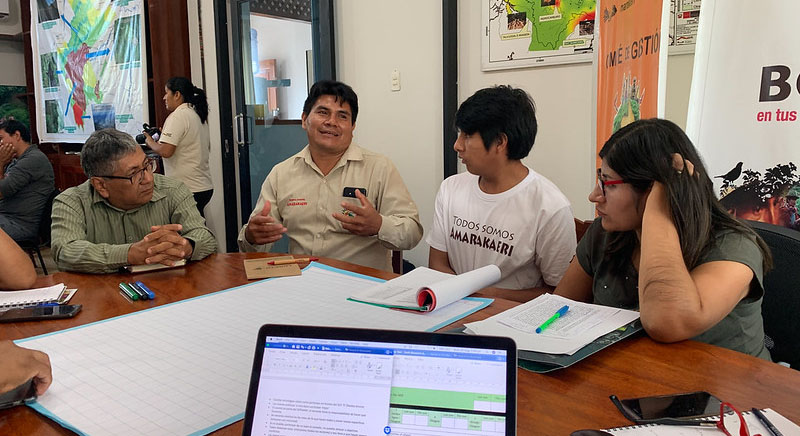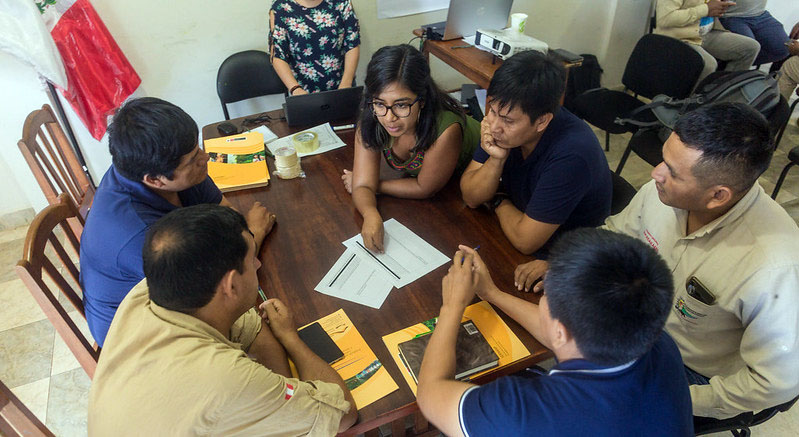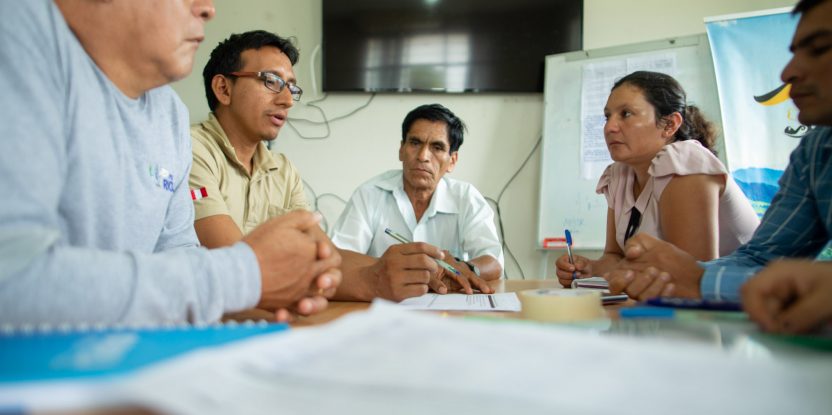Let’s start with a tale of two Brazilian states – and two multi-stakeholder processes (MSPs) that turned out extremely differently from each other.
In the 1990s and early 2000s – in response to calls for participatory land-use planning and concerns about deforestation – Brazil’s state governments began to carry out Ecological-Economic Zoning (ZEE in Portuguese) processes with the aim of collectively laying out land-use plans that were inclusive and sustainable. These processes were mandated to be developed and implemented using multi-stakeholder participatory mechanisms.
Acre and Mato Grosso are two landlocked Brazilian states, both of which contain part of the Amazonian rainforest. Acre’s ZEE map, completed in 2007, was widely hailed for advancing collective benefits and sustainability. For Mato Grosso, in contrast, the ZEE process was disastrous: it reflected deep-seated social and political conflicts, and to this day the state does not have a ZEE map, despite a number of valiant attempts by different parties to develop one. So, why did the two processes, which fell under the same federal mandate, turn out so differently?
Context and engagement
The answer, which Oregon State University postdoctoral researcher Jazmin Gonzales Tovar and her co-authors lay out in a 2021 study, lies in context – and in how the people involved worked within and around it.
Acre is a small state, in a frontier area that has historically been relatively inaccessible for large-scale agro-industrial expansion. It’s located in the Amazon biome and possesses about 86% of its original forest cover; it has a strong history of socio-environmental activism and recognition of the rights of Indigenous Peoples (IPs) and other forest-dependent populations such as rubber tappers. During the ZEE process, the state had a governor who supported these social movements, resulting in a powerful local socio-environmental alliance with aims that were reflected in the ZEE process and objectives (e.g., maintaining Acre’s forests and territorial organization). By request of IP representatives, organisers added a cultural-political axis to the ZEE methodology, a parallel ‘ethno-zoning’ which according to the government sought to transform the map-making process “into a lively living being, consistent with the identity of the populations living in the managed territory”. Care was taken to minimise technical knowledge and power differences amongst participants, and maximise learning and empowerment – through measures such as using simple language; holding regular, smaller meetings; and holding discussions on subjects about which more marginalised actors were knowledgeable.
According to the authors, this process highlighted that power differentials in MSPs are not necessarily obstacles if they are approached strategically and organizers work towards the meaningful and effective participation of historically excluded peoples. “The determinant factor may not be power per se, but how it is wielded,” they said. “It is not necessary for everybody to be an expert; it may be sufficient to develop actors’ capacities to know what to ask and to voice their opinions, as well as to build trust and improve communication among actors.”
Mato Grosso, meanwhile, is a much larger and more accessible state, where much of the land is unequally distributed, deforestation is high, and the agro-industrial sector has historically dominated both the economic and the political spheres: as a case in point, its governor in the early 2000s was Blairo Maggi, a billionaire agribusinessman known internationally as “the king of the soybean.” Here, there was a powerful alliance between high-level state-level authorities and the private agro-industrial sector. Organizers dealt with this by adopting a technocratic approach, and the map was pre-made by ‘technical experts’ using ‘technical’ criteria and was meant to comply with regulations; the MSP had little influence over the map. Complying with the ZEE sustainability and economic diversification stipulations made by the national government would mean a significant shift for the agribusiness-focused state economy. So, private sector interests were reluctant to entertain it, while environmental sector representatives were sceptical of its ability to make genuine impact: one called it “a Machiavellian action of the state government”. MSP facilitators avoided naming and attending to political issues during the process: “We are trying to politicise the commission… but [organisers] want it to be only technical” said one NGO participant cited in the study.

Amarakaeri Communal Reserve MSP – Co-development of How are we doing? Photo by Juan Pablo Sarmiento/CIFOR-ICRAF
The centrality of power
The examples above are a cautionary tale for MSP conveners: a reminder that they ignore non-technical elements like power, politics, and participation at their peril. Processes like territorial planning are inherently political: as Gonzales Tovar et al’s study stated, maps are “powerful instruments that are neither innocent nor objective.”
It’s a common theme in much research on MSPs, which have been reified as a way for diverse groups and organisations to come together to address landscape challenges and are now promoted widely in global efforts promoting sustainable land and resource use in the context of the climate crisis: from the Nationally Determined Contributions (NDC) Partnership to the UN-REDD Program Assembly, the Governors Climate and Forests Task Force, and many more.
But such platforms risk reinforcing or exacerbating inequities and dysfunctions in the territories in which they operate if these social elements remain unaddressed. “Participatory processes do not guarantee equality, as the interactions within them and in the wider contexts where they are enacted are shaped by power relations that define what kinds of actions are possible,” said CIFOR-ICRAF scientists Juan Pablo Sarmiento Barletti, Anne Larson, and Nicole Heise Vigil in a 2021 study on how and why organisers plan their MSPs.
In that context, and over the past six years, these researchers and others at the Center for International Forestry Research and World Agroforestry (CIFOR-ICRAF), along with partners in diverse organisations and locations around the world, have been exploring how MSPs might better achieve their goals in the future, within their Governance, Equity and Wellbeing programme. They’ve found a number of conceptual and practical measures to better take these social dimensions into account. In a 2020 realist synthesis review of land-use-focused MSP case studies from around the world, which began with the analysis of around 100 articles, a CIFOR-ICRAF-led research team identified four common lessons learned:
- the importance of commitment to the people, the process, and its goals, including at higher political levels
- engaging the implementers (key middle-level brokers and government officials) to get buy-in, and identify potential roadblocks and existing capacities;
- openness to learn from and listen to stakeholders; and,
- having a design that is adaptive to its context, with time and resources to do so.
“The central lesson, then, is not one of how to design initiatives, given such different and distinct contexts,” said the authors. “Rather, it is about how to design for engagement to address context, whatever its distinct features, in order to develop and implement initiatives with greater chance of success.”
Another useful lens when considering the equity or otherwise of an MSP is its degree of ‘intensity’ – the degree to which it includes local peoples as part of a forest-landscape solution and addresses issues of equity, inequalities, power, etc. – and ‘embeddedness’ – the degree to which it is part of or connected to wider societal and institutional structures and processes, as a research team led by CIFOR-ICRAF research consultant Christopher Hewlett outlined in a 2021 study. These characteristics are important because an MSP’s “resilience and potential to promote equity is impeded if local peoples are not regarded as key partners and change-makers (rather than ‘beneficiaries’), and if the platform and/or its outcomes are not meaningfully institutionalised.”

Amarakaeri Communal Reserve MSP, Peru. Photo by Pavel Martiarena/CIFOR-ICRAF’
Practical measures
So, how does one design for inclusivity, engagement, embeddedness, and adaptability? Rethinking methods may be key. MSPs “tend to be idealised as imagined spaces for collaboration among equals, despite ample prior research demonstrating that fostering equity in such ‘‘invited spaces” is no easy feat,” said Larson, Sarmiento Barletti, and Heise Vigil in a 2022 study entitled ‘A place at the table is not enough’. “To bring about change – one that takes equality, empowerment and justice seriously – there needs to be greater strategic attention to how marginalised groups perceive their participation in multistakeholder processes.”
Drawing on their work and engagement with 11 subnational MSPs aimed at improving land and forest use practices in Brazil, Ethiopia, Indonesia and Peru – including the aforementioned examples in Acre and Pará – the scientists found that the MSPs perceived most positively by IP and local community (LC) participants used explicit measures to address inequality and ensure participation, such as adaptive, long-term approaches, trust-building, capacity development; decentralised meetings; and separate meeting spaces.
For instance, the Acre MSP, according to participants, went beyond gathering good representation of different groups: it was embedded within the priorities a progressive subnational government; some meetings were held in rural areas closer to communities, rather than always in the capital; and an ‘ethno-zoning’ process was set up in response to IPs’ concerns, which significantly informed the map that was produced. Of course, Acre’s inclusion measures were context-specific; for MSP conveners looking to meet gender and social inclusion goals in their own contexts, CIFOR-ICRAF’s 2021 guide ‘Getting it Right’, led by research consultant Kristen Evans, contains useful, adaptive tools for mobilising existing structures toward inclusivity, and building the necessary capacities to make the most of what participants can offer.
To support participants and implementers in this multifaceted process of making MSPs more equitable and effective, CIFOR-ICRAF has produced a series of simple, accessible infosheets and ‘how-to’ guides. “We often take too much for granted in MSPs,” said Larson. “Some considerations are simple – like changing where the platform is held, or adjusting seating arrangements; and some require deeper strategic thinking. Our research has unearthed a host of practical steps that convenors can take to help empower marginalised stakeholders and create lasting impact.”
Tips to design meaningful, inclusive platforms for transformation
Acknowledgements
This research is part of CIFOR-ICRAF’s Global Comparative Study on REDD+ (www.cifor-icraf.org/gcs). The funding partners that have supported this research include the Norwegian Agency for Development Cooperation, the International Climate Initiative (IKI) of the German Federal Ministry for the Environment, Nature Conservation, and Nuclear Safety, and the CGIAR Research Program on Forests, Trees and Agroforestry (CRP-FTA) with financial support from the CGIAR Fund Donors. This article and the linked info sheets were funded by the Gender, Equity, and Wellbeing (GEW) program at CIFOR-ICRAF.
We want you to share Forests News content, which is licensed under Creative Commons Attribution-NonCommercial-ShareAlike 4.0 International (CC BY-NC-SA 4.0). This means you are free to redistribute our material for non-commercial purposes. All we ask is that you give Forests News appropriate credit and link to the original Forests News content, indicate if changes were made, and distribute your contributions under the same Creative Commons license. You must notify Forests News if you repost, reprint or reuse our materials by contacting forestsnews@cifor-icraf.org.







